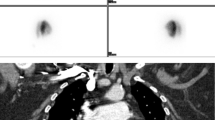Abstract
This study was an analysis of the correlation between pulmonary embolism (PE) and patient survival. Among 694 consecutive patients referred to our institution with clinical suspicion of acute PE who underwent CT pulmonary angiography, 188 patients comprised the study group: 87 women (46.3%, median age: 60.7; age range: 19–88 years) and 101 men (53.7%, median age: 66.9; age range: 21–97 years). PE was assessed by two radiologist who were blinded to the results from the follow-up. A PE index was derived for each set of images on the basis of the embolus size and location. Results were analyzed using logistic regression, and correlation with risk factors and patient outcome (survival or death) was calculated. We observed no significant correlation between the CTPE index and patient outcome (p = 0.703). The test of logistic regression with the sum of heart and liver disease or presence of cancer was significantly (p< 0.05) correlated with PE and overall patient outcome. Interobserver agreement showed a significant correlation rate for the assessment of the PE index (0.993; p< 0.001). In our study the CT PE index did not translate into patient outcome. Prospective larger scale studies are needed to confirm the predictive value of the index and refine the index criteria.


Similar content being viewed by others
Abbreviations
- PE:
-
pulmonary embolism
- CT:
-
computed tomography
- MDCT:
-
multi-detector computed tomography
- DVT:
-
deep venous thrombosis
References
Meaney JF, Weg JG, Chenevert TL, Stafford-Johnson D, Hamilton BH, Prince MR (1997) Diagnosis of pulmonary embolism with magnetic resonance angiography. N Engl J Med 336(20):1422–1427
Wildberger JE, Mahnken AH, Das M, Kuttner A, Lell M, Gunther RW (2005) CT imaging in acute pulmonary embolism: diagnostic strategies. Eur Radiol 15(5):919–929
McEwan L, Gandhi M, Andersen J, Manthey K (1999) Can CT pulmonary angiography replace ventilation-perfusion scans as a first line investigation for pulmonary emboli? Australas Radiol 43(3):311–314
Wu AS, Pezzullo JA, Cronan JJ, Hou DD, Mayo-Smith WW (2004) CT pulmonary angiography: quantification of pulmonary embolus as a predictor of patient outcome-initial experience. Radiology 230(3):831–835
Goodman LR, Curtin JJ, Mewissen MW, Foley WD, Lipchik RJ, Crain MR et al (1995) Detection of pulmonary embolism in patients with unresolved clinical and scintigraphic diagnosis: helical CT versus angiography. Am J Roentgenol 164(6):1369–1374
Drucker EA, Rivitz SM, Shepard JA, Boiselle PM, Trotman-Dickenson B, Welch TJ et al (1998) Acute pulmonary embolism: assessment of helical CT for diagnosis. Radiology 209(1):235–241
Garg K, Welsh CH, Feyerabend AJ, Subber SW, Russ PD, Johnston RJ et al (1998) Pulmonary embolism: diagnosis with spiral CT and ventilation-perfusion scanning-correlation with pulmonary angiographic results or clinical outcome. Radiology 208(1):201–208
Mayo JR, Remy-Jardin M, Muller NL, Remy J, Worsley DF, Hossein-Foucher C et al (1997) Pulmonary embolism: prospective comparison of spiral CT with ventilation-perfusion scintigraphy. Radiology 205(2):447–452
Remy-Jardin M, Remy J, Deschildre F, Artaud D, Beregi JP, Hossein-Foucher C et al (1996) Diagnosis of pulmonary embolism with spiral CT: comparison with pulmonary angiography and scintigraphy. Radiology 200(3):699–706
van Rossum AB, Pattynama PM, Ton ER, Treurniet FE, Arndt JW, van Eck B et al (1996) Pulmonary embolism: validation of spiral CT angiography in 149 patients. Radiology 201(2):467–470
Diffin DC, Leyendecker JR, Johnson SP, Zucker RJ, Grebe PJ (1998) Effect of anatomic distribution of pulmonary emboli on interobserver agreement in the interpretation of pulmonary angiography. Am J Roentgenol 171(4):1085–1089
Safriel Y, Zinn H (2002) CT pulmonary angiography in the detection of pulmonary emboli: a meta-analysis of sensitivities and specificities. Clin Imaging 26(2):101–105
Qanadli SD, El Hajjam M, Vieillard-Baron A, Joseph T, Mesurolle B, Oliva VL et al (2001) New CT index to quantify arterial obstruction in pulmonary embolism: comparison with angiographic index and echocardiography. Am J Roentgenol 176(6):1415–1420
Patel S, Kazerooni EA, Cascade PN (2003) Pulmonary embolism: optimization of small pulmonary artery visualization at multi-detector row CT. Radiology 227(2):455–460
Schoepf UJ, Helmberger T, Holzknecht N, Kang DS, Bruening RD, Aydemir S et al (2000) Segmental and subsegmental pulmonary arteries: evaluation with electron-beam versus spiral CT. Radiology 214(2):433–439
Brunot S, Corneloup O, Latrabe V, Montaudon M, Laurent F (2005) Reproducibility of multi-detector spiral computed tomography in detection of sub-segmental acute pulmonary embolism. Eur Radiol 15(10):2057–2063
Alpert JS, Smith R, Carlson J, Ockene IS, Dexter L, Dalen JE (1976) Mortality in patients treated for pulmonary embolism. JAMA 236(13):1477–1480
van der Meer RW, Pattynama PM, van Strijen MJ, van den Berg-Huijsmans AA, Hartmann IJ, Putter H et al (2005) Right ventricular dysfunction and pulmonary obstruction index at helical CT: prediction of clinical outcome during 3-month follow-up in patients with acute pulmonary embolism. Radiology 235(3):798–803
Wildberger JE, Klotz E, Ditt H, Spuntrup E, Mahnken AH, Gunther RW (2005) Multislice computed tomography perfusion imaging for visualization of acute pulmonary embolism: animal experience. Eur Radiol 15(7):1378–1386
Author information
Authors and Affiliations
Corresponding author
Additional information
This work was supported by the European Commission Leonardo da Vinci grant.
Rights and permissions
About this article
Cite this article
Pech, M., Wieners, G., Dul, P. et al. Computed tomography pulmonary embolism index for the assessment of survival in patients with pulmonary embolism. Eur Radiol 17, 1954–1959 (2007). https://doi.org/10.1007/s00330-007-0577-2
Received:
Revised:
Accepted:
Published:
Issue Date:
DOI: https://doi.org/10.1007/s00330-007-0577-2




